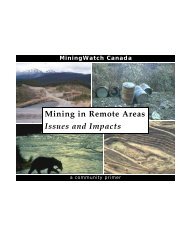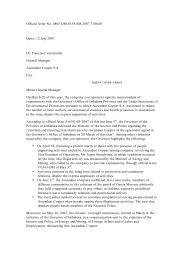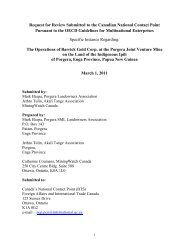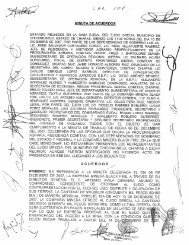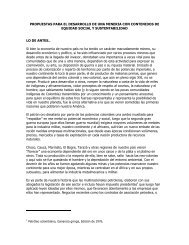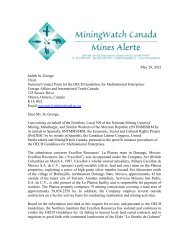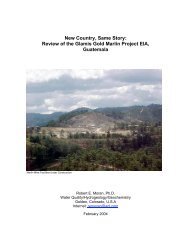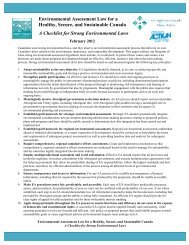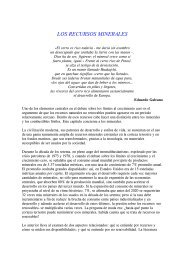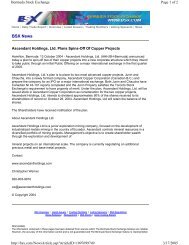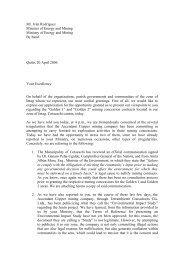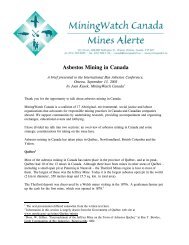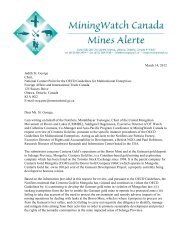Environmental Aspects of Phosphate and Potash Mining
Environmental Aspects of Phosphate and Potash Mining
Environmental Aspects of Phosphate and Potash Mining
- No tags were found...
Create successful ePaper yourself
Turn your PDF publications into a flip-book with our unique Google optimized e-Paper software.
<strong>Environmental</strong> <strong>Aspects</strong> <strong>of</strong> <strong>Phosphate</strong> <strong>and</strong> <strong>Potash</strong> <strong>Mining</strong>Capping Salt Tailings Pile with Demolition RubbleThe Kali und Salz GmbH former Frederickshall operationis located near Hannover in northwest Germany.The relatively small salt tailings pile, containing 11 milliontonnes <strong>of</strong> salt <strong>and</strong> kieserite, closed in 1978.Rehabilitation <strong>of</strong> the pile by capping with demolitionrubble, commenced in 1997, using a patented method.Capping is conducted using inert demolition rubblefrom the city <strong>of</strong> Hannover, 25 kilometres away. The rubbleis delivered to a waste management station locatedadjacent to the stack where it is weighed <strong>and</strong> visuallyinspected. Sampling occurs at regular intervals to checkfor potential contaminants that could present an environmentalhazard. Any metal is removed <strong>and</strong> the rubbleis crushed <strong>and</strong> sorted by coarseness. A portion <strong>of</strong> theaggregate is suitable for resale to be used in new civilconstruction activities.Capping <strong>of</strong> the salt tailings pile is conducted by placingthe coarse fraction adjacent to the salt to create a capillarybreak <strong>and</strong> drainage layer followed by theplacement <strong>of</strong> the fine fraction on the outside. The cappingis designed to leave a stable final slope <strong>and</strong>requires the placement <strong>of</strong> material in a layer from 1 to30 metres thick. After capping is completed, a 3 metrethick layer <strong>of</strong> soil will be placed on the outside as agrowing medium for revegetation.The rate <strong>of</strong> capping is limited by the supply <strong>of</strong> demolitionrubble. At current levels <strong>of</strong> supply the capping isexpected to be completed in 30 years. Monitoring <strong>of</strong> thecapped areas has indicated that capillary action isaffecting only the first 10 to 20 centimetres <strong>of</strong> overlyingmaterial.This capping method appears to provide an effectivemeans <strong>of</strong> isolating salt tailings from the external environment.Additional benefits arise from the recovery <strong>of</strong>formerly l<strong>and</strong>filled urban waste for use as both a saltstack capping material <strong>and</strong> a raw material for new construction.This extends the life <strong>of</strong> the city's l<strong>and</strong>fill.Sorting <strong>and</strong> crushing demolition rubble - Kali und SalzGmbH, GermanyPlacing rubble against salt pile - Kali und Salz GmbH,Germanyto quickly stabilize the surface <strong>and</strong> allow the establishment<strong>and</strong> succession <strong>of</strong> other slower growing species.Topsoil cover provides a suitable growing medium onthe tailings.A number <strong>of</strong> companies have conducted trials todetermine the viability <strong>of</strong> sealing the surface <strong>of</strong> potashsalt tailings piles, to isolate the salt from the environment,allow vegetation to be established <strong>and</strong> leave astable l<strong>and</strong>form. Typically, techniques employed usean impermeable layer to isolate the salt tailings fromthe environment, followed by placement <strong>of</strong> a growingmedium above. The impermeable sealing layer isimportant to prevent water percolating through <strong>and</strong>dissolving the salt, leading to the loss <strong>of</strong> foundations<strong>and</strong> collapse <strong>of</strong> the sealing layer <strong>and</strong> growing medium.A variety <strong>of</strong> sealing layers have been used including:coarse aggregates to prevent capillary action drawingthe salt upwards to the surface <strong>and</strong> impermeable barrierssuch as a plastic liner, bitumen, or cement.The growing medium is placed on top <strong>of</strong> the sealinglayer to allow revegetation <strong>and</strong> prevent erosion. Insome instances temporary stabilization techniques,such as ge<strong>of</strong>abric, may be applied until the vegetationhas established.Conversion <strong>of</strong> the post-mining l<strong>and</strong> use to agricultureor other purposes would require trials to select speciesbest suited to the environment <strong>and</strong> growing medium.



